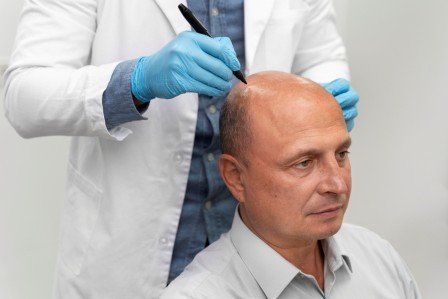Who is the Right Candidate for a FUT Hair Transplant?
Hair loss is a common concern that affects millions of men and women worldwide, often leading to reduced confidence and self-esteem. Thankfully, advances in hair restoration techniques have made it possible to regain natural hair growth and improve overall appearance. One of the most widely used and effective procedures in this field is Follicular Unit Transplantation (FUT)—a surgical method known for delivering long-lasting, dense, and natural-looking results.
But not everyone is an ideal candidate for FUT. If you’re considering hair restoration surgery, it’s essential to understand whether FUT is the right option for you. This blog will help you determine who makes a suitable candidate for FUT hair transplant by exploring the procedure, eligibility criteria, benefits, and factors that influence its success.


Understanding FUT Hair Transplant
Follicular Unit Transplantation (FUT) is a surgical hair restoration technique that involves removing a strip of scalp tissue—usually from the back or sides of the head—where hair is typically more resistant to balding. The strip is then dissected under a microscope into individual follicular units (each containing 1–4 hairs) and implanted into the thinning or balding areas of the scalp.
Key Features of FUT:
- Involves a linear incision to extract a strip of scalp tissue
- Allows the harvesting of a large number of grafts in a single session
- Produces natural-looking results
- Typically leaves a thin linear scar at the donor site, which can be hidden under longer hair
FUT is especially useful in cases where maximum hair density is desired or when patients have significant hair loss.
Ideal Candidate for FUT Hair Transplant: Who Qualifies?
1. Men and Women with Significant Hair Loss
FUT is often recommended for individuals experiencing advanced stages of hair loss, especially those with Norwood scale types III to VII. Because FUT allows a larger number of grafts to be harvested at once, it’s suitable for covering large balding areas.
While it’s most commonly performed on men, women with widespread thinning or patterned hair loss may also be candidates if they have adequate donor hair.
2. Sufficient Scalp Laxity
Scalp laxity refers to the looseness or flexibility of the scalp skin. FUT requires the removal of a strip of skin, so patients with adequate scalp laxity are more likely to experience better results and minimal tension during wound closure.
Patients with tight scalp skin may not be ideal candidates, as it can lead to complications or more visible scarring.
3. Adequate Donor Hair Supply
The success of any hair transplant depends heavily on the quality and quantity of hair available in the donor area—typically the back and sides of the head. An ideal FUT candidate should have a dense and stable donor region, meaning that the hair in these areas is not significantly affected by androgenetic alopecia.
Those with poor donor supply may not achieve desirable results, and alternative treatments or a different transplant method (like FUE) may be considered.
4. Desire for High-Density Results
FUT allows surgeons to extract thousands of grafts in a single session, making it ideal for patients looking to restore large areas of hair loss with maximum density. Because of the strip harvesting method, the follicles experience minimal damage, leading to a high survival rate of transplanted grafts.
Patients who prioritize dense coverage over minimally invasive techniques may find FUT more suitable than other methods.
5. Not Concerned About Linear Scarring
One of the most notable differences between FUT and other techniques, like FUE, is the linear scar left in the donor area. Although often hidden under surrounding hair, the scar may be visible if the patient wears short hairstyles.
An ideal candidate for FUT is someone who:
- Typically keeps their hair medium to long in length
- Is not overly concerned about the presence of a donor scar
- Prefers the benefits of higher graft yield over scar concealment
6. Healthy and Realistic Expectations
Like any surgical procedure, FUT requires patients to be in good overall health, free from conditions that could impair healing (such as uncontrolled diabetes or autoimmune disorders).
In addition to physical health, psychological readiness is crucial. Candidates should:
- Understand the limitations and expected outcomes of the procedure
- Know that results are not immediate, with final outcomes visible in 9–12 months
- Be willing to follow post-operative care instructions for optimal healing
Realistic expectations are key to long-term satisfaction with the results.
7. Previous Hair Transplants or Revisions
FUT is often used for patients who have had previous transplants and need a revision or touch-up, especially when the donor area still has usable hair. Because the strip technique can maximize the graft yield, it’s effective in covering more ground during secondary procedures.
It is also sometimes used for:
- Scar revision from previous surgeries
- Correcting poor hairline design
- Blending old grafts with natural hair
Who May Not Be an Ideal Candidate?
While FUT offers many benefits, it may not be suitable for everyone. Here are some situations where FUT may not be the best option:
- Patients with limited donor hair: If the back and sides of the head have thin or patchy hair, FUT might not provide enough grafts.
- Young patients with progressive hair loss: Early-age hair loss may continue over time, making it difficult to predict future hairline patterns.
- People prone to keloid scarring: Those with a history of developing thick or raised scars may experience poor healing from the strip incision.
- Scalp tightness or low flexibility: Makes it challenging to close the donor wound without tension.
- Those who prefer short hairstyles: The linear scar may be visible with shorter haircuts, making FUE or non-surgical options more favorable.
In such cases, Follicular Unit Extraction (FUE) or medical treatments (such as PRP or medications) may be explored.
Key Benefits of FUT for the Right Candidate
For those who meet the ideal criteria, FUT offers a number of advantages:
- High graft survival rate due to minimal follicle handling
- Ability to transplant a large number of grafts in a single session
- Natural hair growth and dense coverage in balding areas
- Cost-effective for extensive hair restoration (without discussing actual pricing)
When performed by a skilled surgeon, the results of FUT can be life-changing—bringing back not just hair but also confidence and a sense of self.
What to Expect During the Consultation
During your initial consultation, a hair restoration specialist will assess:
- The extent and pattern of your hair loss
- The quality and density of your donor hair
- Your overall health and medical history
- Your goals and expectations
Based on this evaluation, the surgeon will recommend the most appropriate treatment method. In some cases, they may suggest a combination of FUT and FUE for optimal results.
Post-Procedure and Recovery
FUT recovery typically involves:
- Mild discomfort or tightness at the donor site for a few days
- Sutures or staples that are removed after 10–14 days
- Scabbing and shedding in the recipient area (normal process)
- Gradual regrowth of transplanted hair starting at 3–4 months
Most patients can return to non-strenuous work within a few days and resume normal activities within two weeks.
Following your surgeon’s post-operative instructions is vital for preventing complications and promoting healthy growth.
Final Thoughts
Follicular Unit Transplantation (FUT) remains a gold-standard procedure in hair restoration, especially for individuals seeking maximum density and long-lasting results. While it’s not suitable for everyone, it offers unparalleled advantages for those who meet the right criteria—such as having significant hair loss, good donor supply, and a preference for high graft yield.
Choosing the right hair transplant method is a highly personalized decision. By understanding what makes an ideal FUT candidate, you’ll be better equipped to make an informed choice in consultation with your specialist.
If you’re ready to take the next step toward reclaiming your hair and confidence, evaluating your candidacy for FUT may be the perfect place to start.

